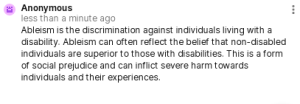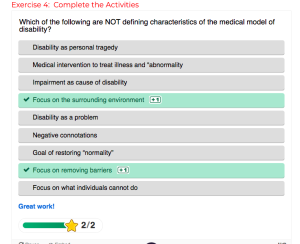5
Section one: The fundamentals
Exercise 1: Notebook Prompt
2) Ability identity security (to be able to be at ease with ones abilities)
I personally know someone with a physical disability who has a good sense of ability identity security. This individual acts on their environment and pushes themselves in everything they do. This individual participates in every sport, drives a vehicle, and goes to work every day. As friends, we foster a safe and encouraging environment, treating everyone as equal and not confining or defining anyone in terms of their abilities. Additionally, if discriminatory comments occur, this individual does not let it get to them, sticks up for themselves, and has a positive social network that supports them. Overall, I have so much respect for this person and am so happy that they don’t label themselves as someone with a disability, are at ease with their abilities, and has a high sense of identity security.
Exercise 2: Implicit Bias Test
Did anything surprise you about the results of the test? Please share if you’re comfortable OR comment on the usefulness of these kinds of tests more generally.
These tests are useful as they work to determine the conscious or unconscious attitudes held by people when it comes to individuals with disabilities. When an individual takes this test, they can see what their scores suggest about the opinions they may or may not have been aware about, and if negative, can promote the need for change in their attitudes.
B) Keywords
Exercise 3:
Add the keyword you contributed to padlet and briefly (50 words max) explain its importance to you.
Ableism
Ableism is the discrimination against individuals living with a disability. Ableism can often reflect the belief that non-disabled individuals are superior to those with disabilities. This is a form of social prejudice and can inflict severe harm towards individuals and their experiences.

B) On Disability
Exercise 4: Complete the Activities



Exercise 5: Notebook Prompt
What do Fitzgerald and Long identify as barriers to inclusion and how might these apply to sport in particular?
Fitzgerald and Long identify several barriers for inclusion, specifically regarding individuals with disabilities in society. Firstly, these authors highlight how the effects of stereotyping and prejudice attitudes can filter into the different participation opportunities that certain groups receive over others and can contribute to their exclusion of sports. These authors also show how policies and lack of proper resources can limit and restrict certain individuals in society, especially those with a disability, from participating equally in sport. Additionally, these authors highlight the importance for the representation of marginalized groups in the media, as this can help promote change, create more inclusion opportunities for these individuals, and prioritize their needs.
C) Inclusion, Integration, Separation
Exercise 6: Complete the Activities

Exercise 7: Notebook Prompt
Choose ONE of the three questions Fitzgerald and Long argue disability sport needs to address and record your thoughts in your Notebook.
Should sport competitions be integrated?
In my opinion, there would be several benefits if sport competitions were integrated. Firstly, this integration would help promote inclusivity of all individuals, and create a supportive and diverse environment for individuals to play in. These environments would challenge ableist stereotypes and highlight the capabilities of people with and without a disability. Additionally, these spaces would help individuals learn from one another, enhance the visibility of people with disabilities in sport, and terminate the misconceptions surrounding disability.
A) Gender, Sport and Disability
Exercise 8: Complete the Activity
The paradox that sportswomen habitually face (as the authors observe, this isn’t confined to disabled sportswomen) involves the expectation they will be successful in a ‘masculine’ environment while complying with femininity norms in order to be recognized as a woman.
True or false?
True. Women are often expected to act a certain way in society, especially in the sport world. While they are expected to have a successful experience in a ‘masculine’ environment, at the same time, they are faced with outside noise and gender stereotypes that insist they comply with femininity norms. These expectations from the public create conflict for women in sport as they actively try to navigate between their athletic performance and their expectations from society.
B) Masculinity, Disability, and Murderball
Exercise 9: Notebook/Padlet Prompt
Watch the film, Murderball and respond to the question in the padlet below (you will have an opportunity to return to the film at the end of this module).
The authors of “Cripping Sport and Physical Activity: An Intersectional Approach to Gender and Disability” observe that the “gendered performance of the wheelchair rugby players can…be interpreted as a form of resistance to marginalized masculinity” (332) but also point out that it may reinforce “ableist norms of masculinity.” After viewing the film, which argument do you agree with?
When reading this question, I believe the film, Murderball, does both of these things. Firstly, this movie shows a form of resistance to marginalized masculinity as it highlights how men living with disabilities can also show aggressive ‘male’ tendencies, especially in the context of playing sports. This shows how this movie challenges the traditional masculine norms that are often limited to men without disabilities.
However, at the same time, this movie may reinforce ableist norms of masculinity as it further places an emphasis on the aggressive qualities and physical toughness that men in society are typically gendered to. Furthermore, the qualities that these men portray in this movie further validates the typical masculine norms associated with dominance.
Section Three: Taking a Shot
B) Calling out Supercrip
Exercise 10: Mini Assignment (worth 5% in addition to the module grade)
When reading this critique, I deeply agree that there is an underlying supercrip narrative in this video. Unfortunately, individuals with disabilities are often linked with the idea that they are ‘beating the odds’ due to their performance and achievements as athletes. This creates a harmful notion that all individuals with disabilities are heroic and extraordinary, and actually diminishes their achievements by placing them in a category that looks at them as a person ‘overcoming’ their condition. Additionally, this promotes unrealistic expectations for those living with disabilities, and those with disabilities who do not want to become athletes, while also overlooking the need for inclusivity of every individual.
There are many conversations in the media surrounding Paralympians that reflect narratives of supercrip. One example is the media coverage surrounding athlete Aurélie Rivard. Aurélie Rivard is a talented athlete with amazing skill, however, the way she is sometimes talked about in the media focuses on her talent based off of her physical condition, not as an athlete. This is evident when some articles talk about how she is ‘unstoppable’ and ‘the brightest star’. Other articles have headlines saying things such as “Aurélie Rivard overcomes demons for gold medal”. These examples show how the supercrip narrative can be imbedded in the media coverage of Paralympians, and can focus on their achievements of ‘pushing through’ with their disabilities rather than focusing on their skill levels as a human first.
Overall, the supercrip narrative can significantly impact the views and beliefs that people can have towards people with disabilities, especially when it comes to their involvement with sport. These narratives categorize these individuals in unfair ways and impairs the experiences of people and athletes living with disabilities. It is heartbreaking to know that some individuals feel as though they have to be an inspiration to others in order to be accepted in society.
2) Does the film Murderball play into the supercrip narrative in your opinion? How does gender inform supercrip (read this blog for some ideas)?(300 words for each response)
The documentary, Murderball, challenges stereotypes, demonstrates that athletes are not defined by their disability, and highlights the individual skills of each athlete. Furthermore, this documentary acknowledges the unique experiences and diverse personalities of the players.
However, at certain points, this documentary may fall into the supercrip narrative. This is evident in the depiction of high levels of aggression and roughness, which can reinforce the notion that these individuals in wheelchairs are ‘overcoming’ their disabilities by adopting traditional gender norms. This falls into stereotypical male expectations, especially in sports, and may suggest to others that these athletes are heroic and exceptional, rather than recognizing them as humans first with great athletic abilities.
I believe gender plays a significant role in this portrayal. Many male athletes with disabilities may feel pressured to ‘prove’ their masculinity by being aggressive and tough, and may feel more of a need to do so to in order to feel accept by others, and sometimes, themselves.
Overall, the documentary, Murderball, does an excellent job of representing athletes with disabilities and challenging perceptions surrounding disabilities in sports.

